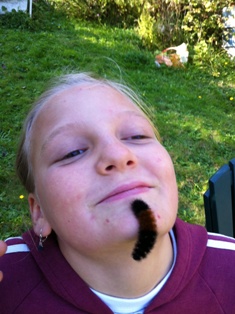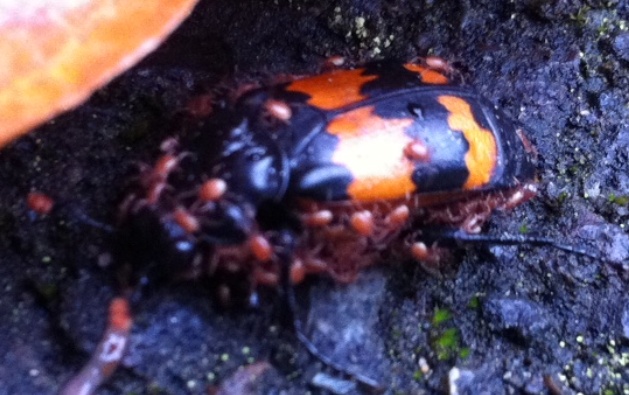I was on a walk last week and noticed two joggers stopping to ponder something on the ground at the edge of the pavement. I had just rescued a woolly bear caterpillar (the larval stage of the Isabella Moth) from a suicidal road-crossing and thought they’d found another one of these relatively cuddly critters.
What I discovered instead was orange and black like the woolly bear, but the similarities stopped there. Far from cuddly, this was an inch-long beetle covered in miniscule wriggling mites. Gary Shugart, collections director at the Slater Museum of Natural History in Tacoma, had recently told me about similarly colored carrion beetles he’d found in a deer carcass he was preparing. He regaled me with stories of the rather macabre and definitely fascinating natural history of one of nature’s more colorful undertakers.
A “nose” for death
My beetle did turn out to be in the carrion beetle family (Silphidae), in the genusNicrophorus, most likelyNicrophorus marginatus. In Greek, necro means death and phor means bearing. The common name for this group is the sexton beetles, a sexton being a church’s groundskeeper and gravedigger.
Sexton beetles do bury their carrion, but not for reasons associated with an afterlife. Also known as “burying beetles,” these insects tend carcasses for food and as part of an unusual reproduction ritual.
Carrion beetles can locate a dead animal within an hour of its demise (up to 1.5 miles away!) using highly sensitive olfactory organs in their antennae. Observe my beetle’s handsome orange-topped smellers. Once they locate the deceased, if it’s the appropriate size (they prefer small vertebrates including birds and rodents) they will bury the carcass to protect it from flies and other carrion competitors (crows, raccoons, flies, fungi, and bacteria to name a few), preserving the feast for themselves.
Breeding Nicrophorus beetles use a small carcass as a sort of wedding bed/nursery combined. After one beetle has found the perfect corpse, it uses pheromones to attract a mate. For the next 24 hours the two work together to bury the dead, stopping intermittently to mate…up to 70 times. The female then lays her eggs in the carcass, and the happy couple stays together to raise their young (feeding them on regurgitated animal remains)—an example of co-parenting rare in the insect world.
Hitch-hiking mites
Another strange and remarkable carrion beetle natural history note relates to the mites teeming over their bodies. From the genus Poecilochirus, these tiny insects have developed a co-dependent relationship with the carrion beetles. The mites get a free ride to their next meal (they eat the eggs and larvae of carrion flies)…an essential transport service considering how difficult it would be to get from one dead thing to the next when you’re only 1 mm long and you can’t fly! The carrion beetles benefit as well because the mites gobble up the carrion competition, preserving more food for the beetles and their young.
There is very little information out there about what insects live on Vashon/Maury and the parts they play in island ecosystems. Help us learn more: Meet any beguiling beetles lately? Send your photos or descriptions to us at info@vashonnaturecenter.org.
Information for this post was found on this useful insect identification website Bug Guide and from an insect database at University of Nebraska.
Happy bug hunting!


